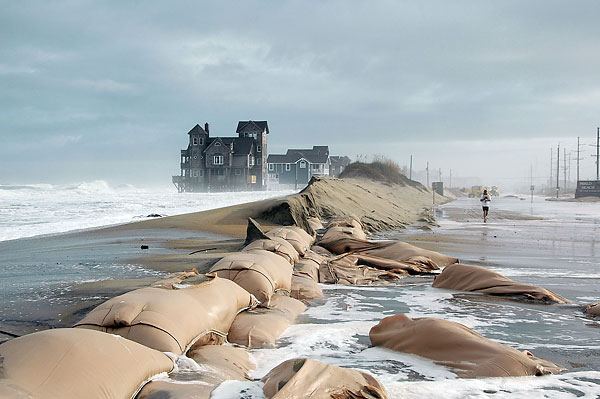Rough Waters Ahead: Climate Change Report Ups Sea-Level Projections

The latest international climate-change report has upped the expectations for rising sea levels as the globe warms — a change scientists anticipated thanks to an improved understanding of the potential contribution from melting ice sheets.
Six years ago, the Intergovernmental Panel on Climate Change's (IPCC) Assessment Report 4 (AR4) projected that sea levels would increase by as much as 1.9 feet (0.58 meters) by the end of this century. In a summary released Friday (Sept. 27), and in a draft unveiled today (Sept. 30), the latest report — the Assessment Report 5 (AR5) — projects sea level increases of as much as 3.2 feet (0.98 m) by 2100.
The primary reason for the increase is that the new report takes into account the potentially large contributions from the enormous ice sheets covering Greenland and Antarctica.
"Projections in previous reports did not account for things like the speed-up of glaciers, which carry ice from the ice sheets to the ocean, or the melting of glaciers that are in direct contact with the oceans," said Josh Willis, a climate scientist at NASA's Jet Propulsion Laboratory in Pasadena, Calif., who hasbeen involved in drafting both the current and past IPCC reports. "Although today's projections are not perfect, they are a bit better than the ones from the last IPCC report (AR4)." [IPCC Reports: Experts React]
The authors of AR4 acknowledged that their projections were likely inadequate, in part because they relied on rates of ice flowing off the Antarctic and Greenland ice sheets from 1993 to 2003. But these rates will likely change as climate change progresses.
A consequence of global warming
Rising sea levels are among the most potentially devastating results of climate change, threatening to swamp coastal cities, infrastructure, and low-lying nations and islands. No one knows exactly how high warming temperatures, which cause water to expand and ice to melt, will push sea levels. However, observations tell scientists that since the mid-19th century, the world has seen faster sea level rise than the average over the previous 2,000 years, and that the rate appears to have continued to increase since the early 20th century, most markedly since the 1990s, the new report says.
Sign up for the Live Science daily newsletter now
Get the world’s most fascinating discoveries delivered straight to your inbox.
"Sea level rise doesn't show any signs of slowing down," Willis told LiveScience in an email.
Because natural fluctuations can influence changes in sea level, it is challenging for scientists to directly attribute any ups and downs to human-caused climate change. However, humans probably bear at least some responsibility for the increasing rate at which sea levels have been creeping up, including the most recent uptick, scientists say.
At the high end
The IPCC reports, which include a comprehensive overview of the physical science behind climate change, provide a reference for decision makers, explaining the general understanding of climate change and its potential effects.
The reports lay out potential sea level increases in ranges. These ranges did not increase uniformly in the new report. Instead, the projections at the high end of the spectrum moved upward, Chris Little, an associate research scholar at Princeton University, said after a quick review of the full report, which was released earlier today.
Changes in the flow of ice off of both the Greenland and Antarctic ice sheets will likely contribute 1.2 to 7.9 inches feet (3 and 20 centimeters) to sea levels by the final 20 years of this century, the new report projects.
The dynamics behind the change are complex, said Little, a contributing author to the AR5. "These do not simply raise or lower the values of the AR4, because other aspects of the sea level projections have changed as well," he told LiveScience in an email.
These projections include new scenarios of future greenhouse-gas emissions, which make comparisons between the two reports difficult, as well as changes involving the expansion of water, glaciers, water stored on land, and the time periods in question, Little said.
Beyond 2100
Sea level rise isn't a new phenomenon. It has been happening since the end of the last ice age, 20,000 years ago, Little said. [Infographic: Global Warming Evidence: 2007 Report Compared to 2013]
The century-long timescale for the projections doesn't capture the full extent of potential changes to sea level in an era of human-caused climate change.
"It is virtually certain that global mean sea level rise will continue beyond 2100," write the authors of AR5.
Water warms more slowly than air does, and the expansion of the oceans as they warm is expected to continue for many centuries, they write.
The new warmth in the ocean must be transported to the ice sheets, and, in time, substantial ice loss could begin, Little said.
So, the dynamics that drive rising sea levels will likely continue long after greenhouse-gas emissions are brought under control, the science suggests.
"It is important to emphasize that this future sea level rise is essentially locked in by 21st-century emissions," Little said.
Originally published on LiveScience.











